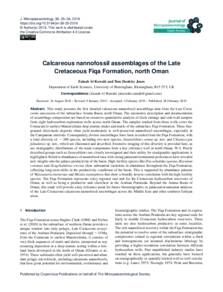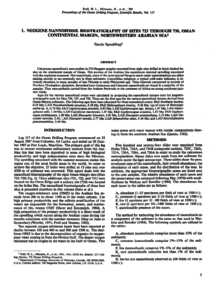Document
Calcareous nannofossil assemblages of the late cretaceous Fiqa formation, north Oman.
Identifier
DOI: 10.5194/jm-38-25-2019
Source
Journal of Micropalaeontology. v. 38, 1, p. 25-54
Contributors
Jones, Tom Dunkley., Author
Country
Germany.
Publisher
Copernicus GmbH.
Gregorian
2019-02-28
Language
English
Subject
English abstract
This study presents the first detailed calcareous nannofossil assemblage data from the Late Cretaceous succession of the subsurface Aruma Basin, north Oman. The taxonomic description and documentation of assemblage composition are based on extensive quantitative analysis of ditch cuttings and side-wall samples from eight hydrocarbon exploration wells across north Oman. The samples studied from those wells cover the Coniacian to earliest Maastrichtian deep marine shales and marls of the subsurface Fiqa Formation. These finegrained siliciclastic deposits often yield moderately to well-preserved nannofossil assemblages, especially in the Campanian intervals. Consequently, diverse assemblages have been recorded from the Fiqa Formation, with a total diversity of ∼ 200 species, including two new species, Staurolithites ormae sp. nov. and Chiastozygus fahudensis sp. nov., which are illustrated and described. Extensive imaging of this diversity is provided here, as are stratigraphic distributions of the main components from a key reference well in north Oman, W-4. Poorly described groups such as Staurolithites are closely investigated and their utility for stratigraphic applications is highlighted. Relative abundances of nannofossil taxa with strong palaeoenvironmental preferences have revealed new insights into the palaeo-productivity of the basin. High-fertility species like Discorhabdus ignotus, Biscutum constans and Zeugrhabdotus erectus show substantial variations in abundance throughout the Fiqa Formation, reflecting long-term shifts in the productivity conditions of the basin. This is supported by abundance patterns of Watznaueria barnesiae and Micula staurophora that show a broadly inverse correlation with the high-fertility species. The Fiqa Formation represents a key regional seal unit for the Cretaceous hydrocarbon reservoirs of Oman, as well as being a productive unit elsewhere in the Arabian Peninsula. Beyond the Aruma Basin of Oman, this study will provide a key reference point for future biostratigraphic or palaeoenvironmental analyses of the Late Cretaceous calcareous nannofossil assemblages across the Middle East and other southern Tethyan areas.
ISSN
0262-821X
Category
Journal articles



